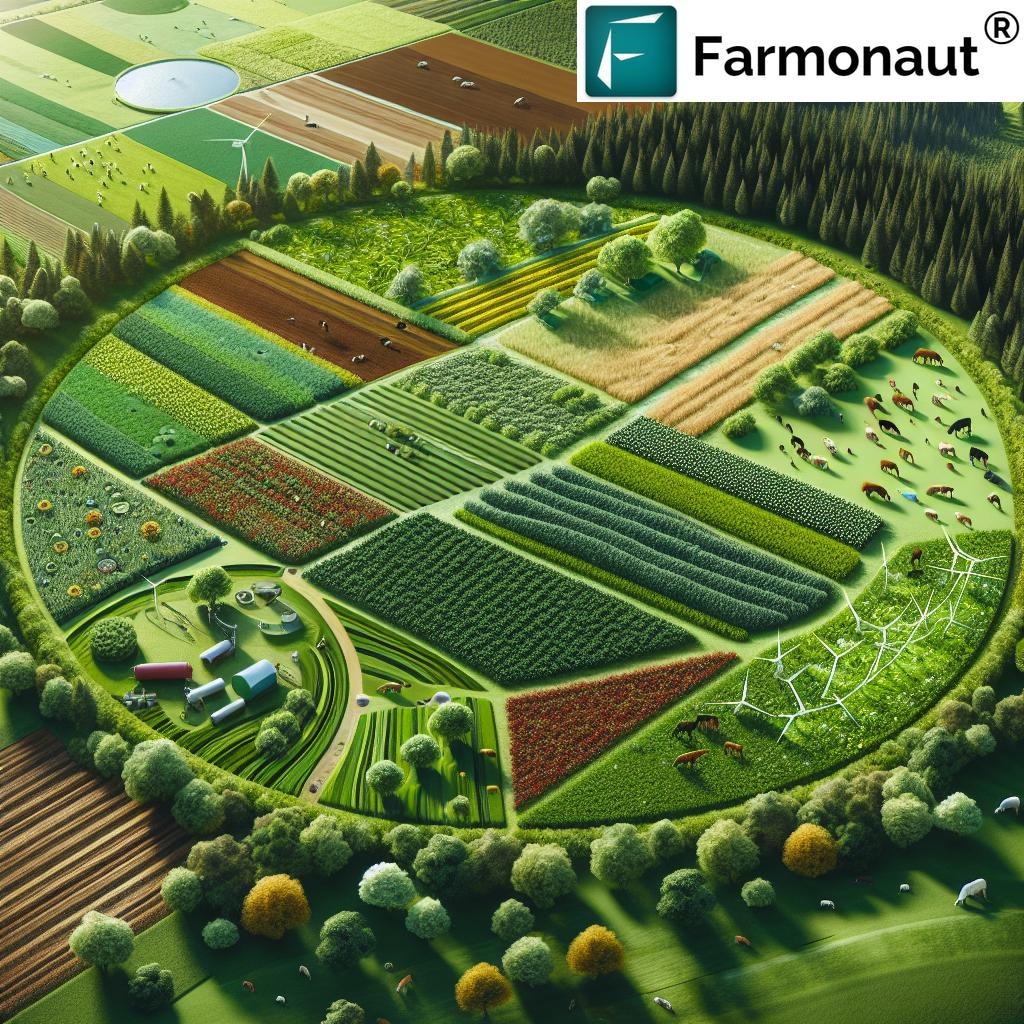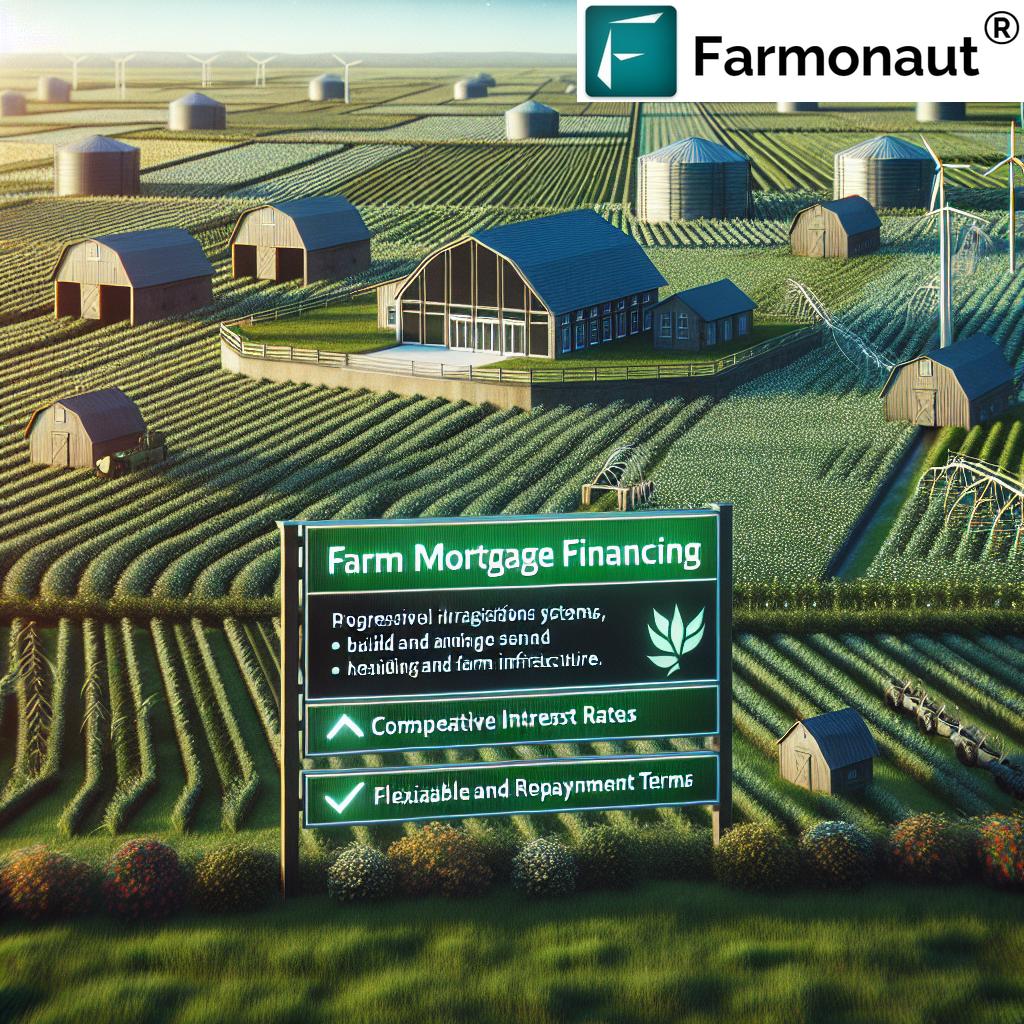Shocking Farmland Hacks: 7 Secrets for Richer Soil!
Table of Contents
- Farmland: The Foundation of Agriculture
- Understanding Arable Land Types & Pasture Land
- The Significance and Role of Farmland in Agriculture and Sustainability
- Challenges in Farmland Sustainability
- Top Strategies for Preserving Agricultural Land
- Shocking Farmland Hacks: 7 Secrets for Richer Soil
- Comparison Table: Farmland Hacks & Their Environmental Benefits
- Integrating Technology: Farmonaut’s Advanced Farmland Management Tools
- Sustainable Agriculture Practices: Ensuring Long-Term Viability
- Economic Value of Farmland & Market Dynamics
- Frequently Asked Questions (FAQ)
- Conclusion: Securing a Resilient Farmland Future
“Healthy soil can boost crop yields by up to 50% through sustainable practices and proper water management.”
As our global appetite for food security escalates, the importance of farmland—our planet’s fertile spaces dedicated to the cultivation of crops and raising livestock—reaches new heights. From producing the grains and vegetables on our tables to maintaining our economic stability and biodiversity, farmland is truly the backbone of agriculture, farming, and forestry.
In this comprehensive guide, we’ll uncover the science behind what makes farmland productive, dive into its vital role in sustainable practices, explore the powerful management strategies deployed worldwide, and reveal seven **shocking farmland hacks** to achieve richer, healthier soil—essential for both new and seasoned farmers striving for impact and resilience.
We’ll also show you how clever technological integration—like the solutions pioneered by Farmonaut—is revolutionizing how we approach soil fertility and conservation, water management in farming, and sustainable crop cultivation methods. Let’s dig deep!
How Farmonaut’s Satellite Technology is Revolutionizing Land Use in Agriculture
Farmland: The Foundation of Agriculture
Farmland isn’t just land; it’s the foundation that sustains every aspect of agriculture, farming, and forestry. At its core, farmland refers to land designated for agricultural use—whether that’s cultivating crops (arable purposes) or raising animals (pasture/grazing).
The quality and suitability of farmland are determined by various crucial factors, including:
- Soil health, fertility, and structure
- Climate conditions and rainfall patterns
- Water availability
- Topography—the land’s elevation, slope, and drainage
These factors create the varied landscape of productive farmland across the globe.
Understanding Arable Land Types & Pasture Land
Let’s clarify the primary types of farmland and their ecological significance:
- Arable Land: This is land suitable for tilling, planting, and growing grains, vegetables, or fruits.
- Pasture Land: Land covered in grasses and vegetation for grazing livestock such as cattle, sheep, and goats.
- Permanent Cropland: Areas where orchards, vineyards, or other perennial crops are grown, requiring no annual replanting.
- Forest Land: Forested areas may be managed for timber, serve as wildlife habitat, and offer essential ecological services.
The Significance and Role of Farmland in Agriculture and Sustainability
Why is farmland the very cornerstone of food security, economic value, and environmental sustainability?
- Food Security: Over 95% of our food comes directly from farmland. From staple grains to fresh fruits and vegetables, farmland supplies essential nutrients that sustain the global population.
- Economic Value of Farmland: Agriculture is a primary income source for billions, supporting employment and economic stability in rural and urban settings alike. The Farmonaut Fleet Management system optimizes logistics, supporting the economic vitality of large farms and agribusinesses by reducing operational costs and resource wastage.
- Environmental Benefits: Properly managed farmland supports biodiversity in agroecosystems, helps sequester carbon, preserves water cycles, and minimizes land degradation.
- Cultural Significance: Farmland preserves rural heritage, landscapes, and traditions—key components of community identity worldwide.
Explore Farmonaut’s Advanced Crop Monitoring & Yield Prediction
Challenges in Farmland Sustainability
Today’s global agricultural landscape faces a series of interconnected challenges that threaten the sustainability of farmland:
- Urbanization and Land Conversion: Rapid urban sprawl is converting fertile agricultural land into residential, industrial, or commercial zones. Farmonaut’s Large-Scale Farm Management App empowers farm managers to document, monitor, and optimize farmland use, aiding in resisting unnecessary conversion.
- Soil Degradation and Erosion: Unsustainable farming practices, overgrazing, deforestation, and excessive chemical use erode and deplete fertile soil.
- Climate Change and Weather Extremes: Erratic weather conditions, droughts, and floods impact crop yields, livestock health, and food security. Real-time weather tracking with precision tools (like those in the Farmonaut Advisory Platform) is vital for proactive farm operations.
- Land Fragmentation: Division of larger farmland into smaller, often less productive plots, decreases efficiency and increases operational costs.
- Loss of Biodiversity: Monoculture and chemical-heavy farming reduce beneficial organisms, threatening essential ecosystem services such as pollination and natural pest control.
Tackling these challenges in farmland sustainability requires holistic management, progressive technology, and continuous education.
“Over 95% of our food comes from farmland, highlighting its crucial role in global food security and biodiversity.”
Top Strategies for Preserving Agricultural Land
Preserving agricultural land is not optional—it’s essential for humanity’s future:
- Farmland Zoning and Land Use Regulations
Implementing agricultural zoning ensures farmland is protected from unsuitable urban or industrial development. For example, agricultural reserves in regions like Montgomery County, Maryland, are pivotal in limiting unwanted land conversion. - Conservation Easements
These are voluntary agreements that legally restrict the use of land to preserve its agricultural or ecological value indefinitely. - Financial Incentives and Grants
Tax relief, direct subsidies, and financial grants encourage farmers to adopt sustainable agriculture practices and maintain their land’s agricultural integrity. - Education and Outreach
Farmers with stronger awareness of sustainable practices and long-term benefits are more likely to implement innovations that help protect farmland.
Large-scale digital monitoring with Farmonaut’s Crop Loan & Insurance Verification adds another layer of security, enabling reliable, satellite-based assessments to document and protect each hectare of productive land.
Shocking Farmland Hacks: 7 Secrets for Richer Soil!
Now let’s reveal the top 7 **farmland hacks**—targeted, science-backed secrets for boosting soil health, fertility, and sustainable productivity on your farm or landholding:
-
1. Embrace Crop Rotation for Soil Vitality
Crop rotation is the practice of alternating different crop species (e.g., legumes, cereals, vegetables) from season to season on the same plot, breaking pest cycles and minimizing nutrient drain.
- Reduces reliance on chemical fertilizers
- Promotes natural nitrogen fixation (especially when legumes are included)
- Supports biodiversity in agroecosystems
-
2. Harness the Power of Cover Crops
Sowing cover crops (such as clover, vetch, rye) between main crops protects soil from erosion, suppresses weeds, and improves organic matter.
- Conserves soil moisture and prevents compaction
- Enhances beneficial microbial activity in the rhizosphere
- Boosts long-term soil structure
-
3. Composting and Organic Matter Addition
Regularly adding compost and organic residues to soil multiplies its fertility and moisture-retaining properties—while recycling farm waste.
- Increases soil carbon content
- Improves texture for better root growth
- Supports soil biodiversity
-
4. Precision Irrigation and Smart Water Management
Harness drip irrigation, soil moisture sensors, and satellite technology (as offered within Farmonaut’s Carbon Footprinting system for environmental performance tracking) to deliver water exactly where and when it’s needed. Efficient irrigation is a core part of water management in farming.
- Prevents over- or under-watering
- Protects against leaching and runoff
- Saves resources and reduces costs
-
5. Reduced Tillage and Soil Conservation
Minimizing tillage preserves soil structure, conserves organic matter, and prevents primary erosion. This is central to any soil fertility and conservation program.
- Promotes natural water infiltration
- Discourages weed spread
- Protects beneficial soil fauna
-
6. Integrate Agroforestry and Natural Habitats
Adding trees and hedgerows to farmland (a practice known as agroforestry) boosts farm biodiversity, fights wind erosion, and even moderates on-farm climate extremes.
- Enhances habitat for pollinators/wildlife
- Reduces chemical needs via natural pest control
- Provides additional economic products (fruits, timber, nuts)
-
7. Leverage Technology-Powered Farm Management Platforms
Deploy state-of-the-art digital tools—like Farmonaut’s satellite-based farm management and crop monitoring suite. These cloud/mobile solutions enable:
- Real-time, field-level crop health diagnostics using satellite data
- AI-driven recommendations for nutrient, pest, and water management
- Automated carbon emissions tracking, yield prediction, and blockchain-based traceability for transparent operations
Learn more about Farmonaut’s API services (integrating satellite/weather data into your existing digital platforms) by visiting the API portal and API Developer Docs.
Unlocking Soil Organic Carbon: The Secret to Sustainable Farming with Farmonaut
Comparison Table: Farmland Hacks & Their Environmental Benefits
| Farmland Hack | Key Sustainability Benefit | Soil Fertility Improvement (%) | Sustainability Notes |
|---|---|---|---|
| Crop Rotation | Increases soil nitrogen, breaks pest & disease cycles | 15-30% | Reduces chemical input, maintains productivity |
| Cover Crops | Boosts soil organic matter, prevents erosion | 10-20% | Improves moisture retention, supports microbes |
| Compost Utilization | Enhances nutrient levels, promotes soil biodiversity | 18-22% | Reduces dependence on synthetic fertilizers |
| Precision Irrigation | Ensures optimal soil moisture, prevents runoff | 12-17% | Conserves water, lowers operational cost |
| Reduced Tillage | Protects soil structure & organic matter | 15-20% | Minimizes erosion, improves water infiltration |
| Agroforestry Integration | Boosts biodiversity, prevents wind/water erosion | 14-21% | Enables multi-layer productivity, increases resilience |
| Digital Farm Management | Enables data-driven resource optimization, early risk detection | 20-25% | Reduces waste, supports sustainable scaling |
Farmonaut | Making Farming Better With Satellite Data
Integrating Technology: Farmonaut’s Advanced Farmland Management Tools
Precision technology is shaping the new era of sustainable agriculture. Farmonaut offers cutting-edge, satellite-powered solutions that open a world of potential for farm management, soil fertility and conservation, and more.
Farmonaut’s Technological Advantages
- Satellite-Based Crop Health Monitoring and Reporting: Obtain weekly or near-real-time updates on crop health (NDVI, soil moisture, stress zones) directly to your web or mobile dashboard—enabling timely action where it matters most.
- AI-Driven Jeevn Advisory: Personalized farm management tips—such as irrigation schedules, pest detection, and nutrient management—delivered using AI analytics.
- Blockchain-Based Product Traceability: Trace the journey of your agricultural products, boosting transparency and consumer trust, especially for food and textile corporations. Explore Farmonaut Product Traceability for an upgrade in supply chain security.
- Resource Tracking and Carbon Footprinting: Monitor energy use, calculate emissions, and develop on-farm sustainability reports with Farmonaut Carbon Footprinting.
- API Integrations: Developers and businesses can directly pipe in satellite and weather data for customized dashboards. Start building with the Farmonaut API and refer to the Developer Docs for seamless integration.
Sustainable Agriculture Practices: Ensuring Long-Term Viability
To maintain and enhance the value of farmland for future generations, we must embed sustainable agriculture into every aspect of management:
- Soil Fertility and Conservation: Nutrient balancing, organic amendments, conservation tillage, and soil testing ensure that we give back more than we take.
- Water Management in Farming: Modern irrigation techniques paired with rainwater harvesting and rigorous scheduling preserve precious supplies and optimize farm operations.
- Biodiversity in Agroecosystems: Cultivating habitat strips, planting diverse crop rotations, and minimizing chemical use foster pollinators and natural pest regulators.
- Forest Land and Agroforestry Systems: The integration of forest elements into agricultural plots (agroforestry) stabilizes microclimates and increases overall resilience.
Farmonaut’s tools are specifically engineered to promote these practices, giving even small-scale and resource-limited farmers access to world-class, data-driven management options.
Economic Value of Farmland & Market Dynamics
Economic factors play a pivotal role in farmland management decisions:
- Market Fluctuations: Prices for commodities change based on supply, demand, and global events, directly impacting farm income and livelihoods.
- Financing & Insurance: Innovative financing (including satellite-based crop verification, available via Farmonaut’s Crop Loan & Insurance services) opens credit and risk buffer options for more farmers.
- Risk Management: Weather insurance, diversification, and up-to-date information assist in weathering occasional market storms.
For ambitious operations, the coordination of machine fleets and logistics can be significantly streamlined using Farmonaut Fleet Management—helping maximize efficiency and reduce costs across planted hectares.
Frequently Asked Questions (FAQ)
1. What determines the fertility and suitability of farmland?
Fertility and suitability are determined by a combination of soil health, climate conditions, water availability, and topography. Regular testing and precise management can enhance these factors.
2. How can I prevent soil erosion on my farm?
Reduce tillage, cultivate cover crops, integrate agroforestry, and maintain natural habitats along field borders. These strategies help hold soil in place and protect organic matter.
3. What are the most sustainable irrigation systems?
Drip irrigation and soil moisture sensor-based systems are the most resource-efficient, reducing water waste and preventing over-irrigation.
4. How can biodiversity be supported on agricultural land?
Planting diverse crops, maintaining forested areas, introducing pollinator habitats, and using fewer chemicals all support biodiversity and ecosystem health.
5. What digital tools can help improve farmland management?
Platforms like Farmonaut provide satellite crop monitoring, AI-driven advisories, resource tracking, and blockchain-based traceability, all designed to enhance productivity and sustainability.
Conclusion: Securing a Resilient Farmland Future
Farmland is the primary foundation of global agriculture, food security, and rural economies. By championing soil fertility and conservation, integrating technology for farm management, and embracing proven sustainable agriculture practices, we can rise to the pressing challenges in farmland sustainability.
The **seven farmland hacks** outlined above—rooted in data, tradition, and modern science—deliver both immediate and enduring ecological and economic benefits. By adopting a holistic approach that couples these practical secrets with technology like Farmonaut, we ensure farmlands continue to provide for generations to come.
Whether you manage a single hectare or vast farming operations, your choices matter. Connect with advanced solutions using the Farmonaut App on web, iOS, or Android. For those seeking to build or scale digital farm platforms, the Farmonaut API and Developer Docs are at your disposal.
Now is the time to act—preserve, protect, and enhance your land for a greener planet and a thriving agricultural legacy.











